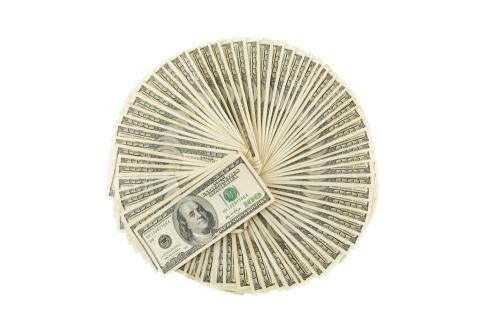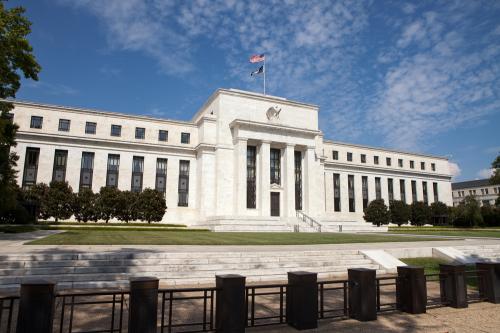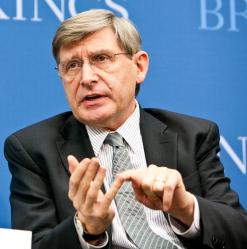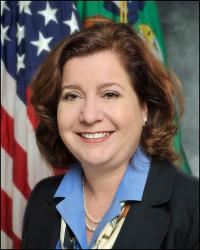Economists have long debated the potential for rising wages and prices to push each other increasingly higher, driving inflation out of control—the so-called “wage-price spiral.” Concern about such a spiral has been high in the post-pandemic era, with inflation still running notably higher than the Federal Reserve’s 2% target. On this episode of the Brookings Podcast on Economic Activity, Martin Neil Baily of Brookings talks with the authors of a new BPEA paper on wage-price spirals, Guido Lorenzoni and Iván Werning. Their study, which developed a new model for this economic scenario, contends that because various factors drove price growth to outpace wages just after the pandemic, wages can increase faster than inflation, at least for a time, without necessarily spinning the economy out of control.
- Listen to the Brookings Podcast on Economic Activity on Apple, Spotify, or wherever you like to get podcasts.
- Learn about other Brookings podcasts from the Brookings Podcast Network.
- Sign up for the podcasts newsletter for occasional updates on featured episodes and new shows.
- Send feedback email to [email protected].
Transcript
[music]
EBERLY: I’m Jan Eberly, James R. and Helen D. Russell Professor of Finance at Northwestern University.
STEINSSON: And I’m Jón Steinsson, Chancellor’s Professor of Economics at the University of California, Berkeley.
EBERLY: We’re the coeditors of the Brookings Papers on Economic Activity, a semiannual academic conference and journal that pairs rigorous research with real time policy analysis to address the most urgent economic challenges of the day.
STEINSSON: And this is the Brookings Podcast on Economic Activity, where we share conversations with leading economists on the research they do and how it will affect economic policy.
Today we’re going to hear a discussion with Iván Werning, the Robert M. Solow Professor of Economics at MIT, and Guido Lorenzoni, the Joseph Sondheimer Professor of Economics at the University of Chicago Booth School of Business, coauthors of the new BPEA paper, “Wage-Price Spirals.” They’ll be interviewed by Martin Neil Baily of Brookings.
EBERLY: And Martin should have some interesting perspectives for this paper because he wrote a BPEA paper on this subject back in 1978 with George Perry and William Poole, which is the last time the U.S. had a serious bout of inflation like we’ve seen in the last couple of years.
STEINSSON: Yeah, every time inflation rises, whether it’s in the United States or in other countries, there’s a lot of discussion and a lot of worry about wage-price spirals. The basic idea is that workers demand higher wages, that their wages can catch up with the increase in cost of living, but the higher wages result in higher costs for firms which lead the firms to raise prices even more, and that results in even higher wage demands and so on.
This is, of course, a very intuitive idea, which rings true in many inflationary contexts. But perhaps surprisingly, it’s an idea that economists have had a hard time building into their models. Now, Iván and Guido’s paper, I think, is really exciting because it shows how a wage-price spiral is actually hidden inside the models that economists already used to think about inflation.
EBERLY: It is an interesting and a novel approach, because it’s driven by shortages of other inputs like energy or materials, as we saw in the aftermath of COVID-19. But results in what appears to be a wage-price spiral in the data. They also come to a relatively optimistic conclusion of the spiral, with real wages returning to trend and not being persistently undermined by inflation.
[music]
STEINSSON: Yeah, and I also found the analysis of optimal policy quite interesting in this paper. They argued that there are times where it is optimal for the central bank to quote unquote run the economy hot. That is, endure some excess inflation when the economy is doing well. But let’s hear from Martin, Guido, and Iván.
[00:03:08]
BAILY: Thank you, Jan and Jón. I’m really very pleased today to have two very distinguished economists to talk about an important topic—wage price spirals. So welcome Guido and welcome Ivan to the Brookings podcast.
So, there’s still a lot of concern about inflation, even though inflation has been coming down in the U.S. most, and coming down a bit in Europe also. There’s still a lot of concern. Policymakers and the Federal Reserve is worried about it. Certainly, as we record this, the labor market still looks very strong. So could you start by giving us a definition of wage-price spirals?
WERNING: That’s a great question because that’s how we started this project. We felt and found that there really wasn’t any commonly accepted definition for a term that’s used a lot. Broadly speaking, it sort of conveys a generalized inflation process where both prices and wages are rising and maybe an idea that prices are rising because wages are rising and vice versa, wages are rising because prices are rising in this sort of self-perpetuating feedback.
And some people use it for a steep increase in prices with wages, and sort of a spiraling out of control more notion. And yet other people use it as an episode where maybe wages rise first and then prices follow, although it’s not so clear which variables should follow the other.
But, all these ideas are hard to operationalize, I think, in terms of defining an episode as a price spiral or not, a wage-price spiral or not, perhaps because there are slightly ambiguous definitions. So, we we took a different take, which is to think of the economic concept, mainly the feedback idea, and took a look at kind of the economic logic as crystallized in macroeconomic models.
And we concluded that this feedback is always there. So in that sense, a wage-price spiral is always present. And that formed the basis for our notion of wage-price spirals. What we showed is it’s a component of inflation that is the most persistent and generalized across sectors, and generalized across prices and wages. But in that sense, it’s a feedback or spiral that’s always present.
[00:05:36]
BAILY: So in my own history, I was starting in the ‘70s and ‘80s, I was writing Brookings Papers about inflation. I even wrote one looking at ways to make wage and price controls more efficient, although that paper didn’t go down too well in the meeting, I have to say. But there were some other ventures.
So, back then, if I remember back to that time of the ‘70s and early ‘80s, there was a very strong sense that wage-price spirals were a very important phenomenon. And that it was sort of a chasing your tail kind of thing where first wages went up and then prices and then wages again and then prices. So, that you were kind of chasing your tail in a way that nobody got ahead, but the process continued and created a lot of discomfort and a lot of political turmoil.
So, why do why do wage-price spirals or do you agree that wage-price spirals create a kind of particular challenge when they do occur?
WERNING: Yeah, we agree that the ‘70s maybe is the prototypical idea of a wage-price spiral, although, you know, we think that our notion of wage-price spiral wouldn’t say this episode or that episode is a wage-price spiral and that one is not. The fact that wages and prices went roughly in lockstep in the ‘70s, it fits in with our notion that it’s this feedback.
There’s a contrast there with recent events where prices and wages have reacted differently and there’s a different timing to them.
[00:07:07]
LORENZONI: One thing that I wanted to add is that our way of cutting through the model and looking at the model, I think emphasizes the fact that indeed when there is high inflation, there is an element of disappointment on both sides. So, in that sense, high inflation kind of corresponds to a moment of conflict also because like people are constantly disappointed by the real outcomes that they’re getting out of their nominal deals. And so in that sense, that fits well with your description of the experience of the ‘70s.
BAILY: So, workers are trying to get ahead and then the firms are trying to make sure that they maintain their markups and then both of them get kind of squeezed or in a difficult situation.
Your new paper, the one that you gave just recently at the Brookings panel, I think you conclude, if I’m understanding you correctly, that the United States actually does not currently have the problem of a wage-price spiral.
So, can you let us know how you come to that conclusion? Because after all, a lot of people out there, non-economists might say, well, heck, we’ve had a lot of wage increases, a lot of price increases. Why isn’t that a wage-price spiral?
[00:08:18]
WERNING: Great question. Yes, of course both wages and prices have risen. And in the general notion of there being a feedback, there’s been a spiral. But I would draw on the distinction we made that it’s not a spiral in the sense of spiraling out of control or necessarily being very difficult to stop, as you mentioned earlier.
And so here, I think timing makes all the difference. In 2021 and ‘22, prices rose rather quickly, much more than wages. And more recently prices have fallen and wages have remained at a high pace of growth. Some calculations that they’re beyond productivity growth.
So, the first point I would make is that these two phases have to be seen together—so they’re not in isolation. In other words, right now we’re not at ground zero and so initially the real wage took a fall and now there might be room for the real wage to rise back without necessarily creating additional inflationary pressures.
The other piece of the puzzle is that it’s not just about wages. There’s another piece of the puzzle here, which is if you think about other inputs—energy, chips, the cost of shipping, lumber, et cetera—these saw a very high and fast rise early on in the expansion and have been falling. So, that also creates more room for wage growth without necessarily putting inflationary pressures.
[00:09:57]
BAILY: Yeah, so you emphasize, correctly I think, that supply shocks—things like the difficulty of obtaining chips or access to Russian oil or then wheat as well; so that these commodity price increases, which afflicted the economy in the 1970s as well—have contributed to the pattern of both wage and price inflation that you see. So those supply shocks are playing a big role. Perhaps you could talk a little bit more about that.
WERNING: Correct. These supply shocks we think contributed a lot to the increase in prices. And that explains why what we saw is an increase in prices, you know, not coming from the labor market necessarily.
So that contrasts with, interestingly, at the beginning, before inflation really took off, a lot of economists were worried about the prospects of inflation and predicted inflation would rise if the stimulus bill was passed with a size that was proposed and with the Fed not tightening sooner.
And those predictions were borne out, interestingly. However, the inflation did not arise in the same manner as they predicted. There was a lot of concern at the time about the overheating labor market. And so there was a view, I think, that this inflation would be wage-led, and that didn’t pan out.
And our analysis incorporates these inputs as an important element to explain the rise in inflation ahead of wages. So, the inflation is led by the rise in these input prices. And only afterwards does the wage through the feedback, through wage-price spiral feedback, rise. And eventually when these supply constraints dissipate or get relaxed, there’s room for wages to rise above price inflation without necessarily implying a huge concern that it will spiral out of control.
[00:12:02]
BAILY: Now, a lot of people have over the years have thought about inflation in terms of too much money chasing too few goods or it may be a little bit differently in terms of excess demand, too much demand for the available supply. So, what role do you think that played? I know there was a lot of government spending that was introduced I think last year, and there were warnings that would trigger inflation. And after all we have had inflation. So, what’s the role of demand and where do you think the sources of that are coming from? Would you blame fiscal policy? Or is the Fed really asleep with the switch? Tell us a bit about the demand side of things and how that’s played into this.
LORENZONI: Yeah, so, our analysis kind of emphasizes that the effect of demand and the effect of supply shocks, once we are in an economy where supply constraints are close to be binding and tight, then demand and supply shocks actually play out in kind of a similar way also in terms of what their impact on inflation and in real wages. And that’s kind of part of our message.
There is an optimistic side to this way of thinking about the problem, which is like, yeah, at the core, there is a problem of excess demand. So, in that sense, the period of high inflation is too much demand for the level of supply that the economy can produce.
On the other hand, there is an element which is that some people have mentioned a nonlinear Phillips curve, and I say if you have a nonlinear Phillips curve, excess demand can very rapidly create inflation, but then it can also very rapidly create disinflation if you move back down the Phillips curve.
So, that means that essentially as you overheat the economy, just a bit of a nonlinear Phillips curve would suggest that there is a point where you reach capacity constraints, where the economy really reaches its potential. And from then on, increasing activity above that level causes marginal costs to go up very fast, basically. Like, maybe there is a region where marginal costs are flatter, where you can increase production without facing very high costs. But at some point the the relation becomes steeper. And so then the relation between excess demand and and between the output gap and inflation also becomes steeper so that a bit of overheating causes inflation fast.
Now our paper is a bit different because our paper doesn’t emphasize the labor market Phillips curve. Actually, our paper is consistent with the labor market Phillips curve, it’s pretty flat. But it emphasizes now the goods market Phillips curve that has to do with the scarcity of all the non-labor inputs and says, well, on the goods market Phillips curve, you get a similar message. You can have a very steep non-labor input Phillips curve where you get the price of all these scarce inputs going up very fast if there is a moment of excess demand.
But at the same time, once the excess demand is resolved, you’re going to get inflation down relatively quickly.
[00:15:11]
WERNING: Another aspect of policy is what we should be doing now or next. And I would say our optimistic scenario implies that further monetary tightening may not be necessary going forward if that optimistic scenario is right in the sense that inflation can return to normal and wage growth might return to normal more slowly.
Our analysis also leaves a lesson, I think, for the future in the sense that it underscores that monitoring the labor market condition to take a pulse on the inflationary pressure is not enough. It doesn’t give you a complete picture. And it’s important to think about this tightness that Guido was talking about in the input and good market. So we think we think that’s a very important lesson.
BAILY: Well, that’s encouraging news if you feel that we don’t necessarily need more monetary tightness. That would certainly be welcome to many people. And you’ve explained it, but maybe can you expand on that a little bit? Because I think there are folks who think, oh no, the Fed was behind, didn’t raise rates fast enough, and now they’ve got to make up for that, and we really have to see rates go up even further. Even some of the Fed governors have wondered about that, not all of them.
So, what’s the thing that allows you to or encourages you to say that we don’t necessarily need more demand constraint through tighter monetary policy to get past this inflation?
[00:16:42]
WERNING: Everything will be on a data-based timeline, of course, but we were speaking to the fact that seeing inflation fall while still seeing high wage growth has kept some people concerned about inflation and thinking that there was more to be done. So, that’s where our paper, I think, can fit in.
Under our optimistic scenario that kind of pattern is not necessarily indicative that we’re not out of the woods. It’s consistent with the idea that we are on a path to return to normal, to a soft landing.
Of course, things going forward can point in a different direction. And I would like to add that we, as good two-handed economists, in the paper include a less optimistic scenario. Our optimistic scenario is based on the benchmark where expectations are rational. But we also include an analysis where expectations are more backward looking and adaptive, and they have gone up. And now that inflation is coming down, they don’t come down fast enough. And that can lead to, of course, inflation and wage growth staying higher for longer without further Fed actions.
So, that’s something to take into account and maybe one has to parse what the data on inflation expectations is saying going forward.
BAILY: Well, correct me if I’m not giving a correct interpretation here. But so what you’re modeling, you have a fairly complicated set of models here, but one of the things you’re drawing out of this is if we look at the current situation where price inflation has come down, wage inflation maybe hasn’t come down as much, but because of your understanding of the interaction between those two, that leads you to be perhaps a little bit more optimistic than some people are about what the future path of inflation will be. Is that an understanding of your comment?
WERNING: That’s perfect. And I think it sums up in the idea that we’re not at ground zero. That we have to remember that prices rose more than wages previously. And also that previously the prices of inputs were higher than they are now, of several inputs were higher than they are now. That’s what’s giving room for firms not to feel the need necessarily to raise prices, and allow more room for wages to grow.
[00:19:01]
LORENZONI: I think that from an empirical perspective, the question that one faces today, which I think our paper kind of poses the question in a sense, is like we see wage growth still being sustained. And there are two interpretations of that. One interpretation, I would say, is labor markets were hot throughout. We had too hot of a labor market. We didn’t see that, like, the labor market kind of maybe takes some time to to transmit the hotness to the wages. But now we see it. And so now there is this persistent thing. And unless we see the labor market really cooling off sensibly, we’re not going to get rid of that. That is going to be some underlying inflation we’re not going to get rid of.
And our paper shows that there is a different interpretation in which this wage growth that you get kind of at the end of the cycle is more like kind of like an aftershock. Like you had a wave, the first wave was in price inflation, but then you have multiple waves. Actually, we have more waves than that. We have a first wave was goods inflation that was very strong. Then we got a wave in service inflation. And then kind of wages are kind of more lagging. So it’s it’s normal to see relatively high wage inflation at this stage of a shock like this.
The hard empirical question is how much can we attribute to our force relative to a view in which instead the labor market is still too hot.
[00:20:25]
BAILY: Okay, that’s great. A lot of the meat of your paper for an economics audience is in the technical analysis and the modeling that you do, which is too mathematical for our readers to digest right away. But I wanna give you the opportunity to talk a little bit about that. You’ve done some new things. This is a literature that goes back. Quite a few people have written models—Olivier Blanchard notably, for example—about wage-price spirals. And you’ve got a new way of looking at this. There’s some differences in the way you do it from what other people have done. So, can you tell us a bit about what’s distinctive in what your modeling is? And to what extent has that enabled you to answer some of these questions about the actual experience of our economy?
WERNING: Sure. Let me start by saying, we definitely stand on some giants’ shoulders here and have benefited from much of that literature you mentioned. I would say our models, though not so complicated and the analysis actually is is quite simple, but the model in other words is close to a pretty advanced textbook. And we feel that kind of analysis has not been used enough. It’s not been incorporated into the policy debate.
So, the way we view what’s out there is when people discuss policy, when you read a Fed speech or when you see someone who tracks the Fed or argues about what the Fed should do, they’re using even a very very simple macro model in their mind that is sometimes almost macro 101, ISLM, aggregate demand. And that is very useful a large part of the time.
And on the other hand, within Feds, there’s a research department, there’s a very complicated model, DSG model, but that’s usually not used in the same way. It’s used to do forecasts.
What we feel our paper lands is somewhere in between, closer to the simpler models actually, but somewhere in between. And hopefully, we’re hoping to elevate the policy discussion with these slightly richer models. In particular, we think this idea of inflation is not always wage-led and that you can get these dynamics of the real wage are very important and actually turn out to be very intuitive and very simple. So, the math is there, but I think the ideas are actually quite simple. This idea that you’re not always at ground zero and you always have to think of the Phillips curve as if it were a static relationship.
Instead, you know, what our analysis brings out is that something like the real wage is affecting that Phillips curve. And if the real wage is lower now, or if the prices of inputs have come back down, then there’s less pressure on inflation. And it’s not just all about the output gap.
So, that is our simple takeaway. And our hope is that there’s a contribution here conceptually. In the forum, we take the analysis, which we think is quite intuitive, and also in terms of explaining these recent episodes and providing a way of thinking that’s useful for policy debates.
[00:23:44]
BAILY: Yeah, that’s terrific. And I want to say that kind of modeling is my kind of modeling. I love that kind of stuff. So I applaud what you’ve done there. And as you say, either we tend to get very simplistic views of the world or else we get these very complicated models, which are more or less, often less, effective, at forecasting the future.
And so to be able to use the kind of model that you use to give insights into this important topic of wage and price spirals and how wage and price inflation and deflation gradually unfold, I think that’s terrifically valuable. So, really appreciate what you’ve done there.
LORENZONI: I may add one thing. We didn’t discuss it too much during the Brookings presentation or today because it’s also the most tentative part of the paper is where we try to discuss kind of optimal policy, which is always a hard question.
At the end of the day, if you have a period of positive output gap, excess demand that causes inflation, that is a policy mistake in the sense that is something that you could have prevented, that inflation would have been prevented by the right path of aggregate demand.
But the paper points out that it is not an obvious welfare proposition that setting the output gap always to zero would be the optimal thing to do in this economy. There are reasons why it’s possible that an overheated economy may have some welfare benefits.
So, some of the reasons are in the paper. Some of the reasons are actually not in the paper, but are in our previous Jackson Hole paper that emphasized more the benefit of relative price adjustments, and the fact that sometimes an overheated economy can achieve relative price adjustments more quickly.
So, it’s kind of more an open-ended question of how to think about optimal policy in episodes like this. And I think it’s something where there is some some in the paper, but there is also a lot more to do, especially thinking about the future and how to deal with future supply shocks.
[00:25:53]
BAILY: Well, you’ve opened a door and I’m going to go through it. So, the Fed has had a 2% target for a long time. And Ben Bernanke introduced that and has sort of established that as a fairly firm target. Is your argument that maybe it’s time to raise that target or is that not where you were going with it?
LORENZONI: No, my argument was more like in response to some shocks, how fast do you want to go back to target? I don’t want to open the discussion on the target. It’s a very interesting discussion, but I just don’t want to—
BAILY: That’s not what you were trying to do.
LORENZONI: That’s not where I was trying to go. I was just saying, in response to supply shock, is it true that we want to let the supply shock play out and not try to cool down the economy too much? Now in in a super standard models, the policy prescription actually would be no, even if it’s a supply shock, just cool down the economy, just bring the economy at potential always. And that’s the best.
And I think that proposition, which is true in some very simple models, is not true in general. And understanding better what is the best response to a supply shock or to a transitory period of excess demand I think there there are very fascinating questions of kind of welfare economics and aggregation that are still open.
WERNING: Yeah, our Jackson Hole paper specifically had an economy with multiple sectors and asymmetric shocks. And in that environment we showed those two features are an important part of the recent episode. If we think of what makes COVID and the recession from COVID and the expansion after that different is that there has been a huge shift across sectors. It’s not just even transitory. Part of that shift is permanent and there’s a reallocation process that’s in the transition.
So, we have tried to emphasize in this other paper that can feed into what looks like in aggregate terms a cost-push shock. Which implies that the trade-off between inflation and output is just shifted and is worse. And that naturally implies that you have to accept some inflation and maybe lean against it, but not fully, not expect to be able to go all the way to to to avoiding it.
That’s a separate paper. It’s not part of this analysis, but it’s part of, you know, the way I think about this episode, like Guido said, that’s not the last word on it. We think that model has some virtues, but there’s a lot more to be done thinking harder about these shifts.
[00:28:40]
BAILY: Well, maybe this is a digression, but when I was in the Clinton administration, I went and visited the Bank of England. And we had a very lively debate because I followed what was basically the Greenspan doctrine, which is that if you had a supply shock, you didn’t necessarily try to push the price all the way back down and create a lot of unemployment just to offset a higher price of oil, particularly, let’s say, if it was a sustained higher price of oil.
And the Bank of England was very indignant about that, and they kept saying, well, people don’t consume the adjusted CPI. They consume the actual CPI, so you’re really distorting the thing.
Maybe I’m straying too far here, but I got a sense from what you’re saying is that If you’ve had a supply shock, well by which we might mean a big increase in energy prices, you wouldn’t necessarily want to have lots and lots of unemployment just to try to offset that and get back to where you were.
Well, this has been a really stimulating and interesting time, and I’m delighted to have had the chance to talk to you, Iván, and you, Guido. It’s a really interesting paper, and thank you for being here.
[music]
WERNING: Thank you so much for having us.
LORENZONI: Thanks a lot.
STEINSSON: Once again, I’m Jón Steinsson.
EBERLY: And I’m Jan Eberly.
STEINSSON: And this has been the Brookings Podcast on Economic Activity. Thanks to our guests for this great conversation and be sure to subscribe to notifications about new releases of this podcast.
EBERLY: The Brookings Podcast on Economic Activity is produced by the Brookings Podcast Network. Learn more about this and our other podcasts at Brookings dot edu slash podcasts. Send feedback to podcasts at Brookings dot edu, and find out more about the Brookings Papers on economic activity online at Brookings dot edu slash BPEA.
STEINSSON: Thanks to the team that makes this podcast possible, including Kuwilileni Hauwanga, supervising producer; Fred Dews, producer; Gastón Reboredo, audio engineer; with the support from Shannon Meraw and Chris Miller of Economic Studies at Brookings. Show art was designed by Katie Merris at Brookings, and promotional support comes from our colleagues in Brookings Communications.
The Brookings Institution is committed to quality, independence, and impact.
We are supported by a diverse array of funders. In line with our values and policies, each Brookings publication represents the sole views of its author(s).













Commentary
PodcastHow worried should we be about wage-price spirals?
December 7, 2023
Listen on
Brookings Podcast on Economic Activity